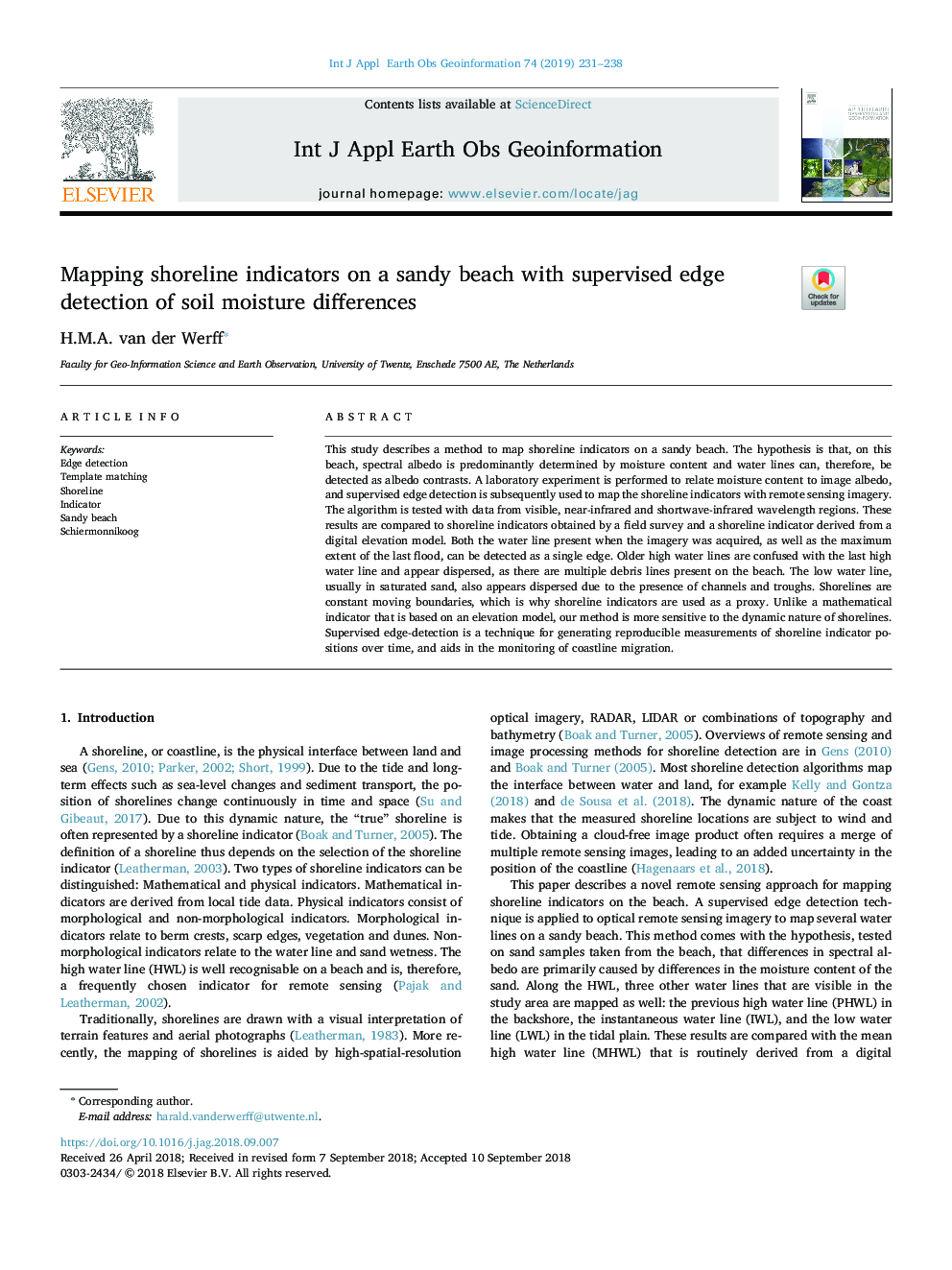| کد مقاله | کد نشریه | سال انتشار | مقاله انگلیسی | نسخه تمام متن |
|---|---|---|---|---|
| 11028674 | 1646758 | 2019 | 8 صفحه PDF | دانلود رایگان |
عنوان انگلیسی مقاله ISI
Mapping shoreline indicators on a sandy beach with supervised edge detection of soil moisture differences
ترجمه فارسی عنوان
نقشه برداری شاخص های ساحلی در یک ساحل شنی با تشخیص لبه تحت نظارت از تفاوت های رطوبت خاک
دانلود مقاله + سفارش ترجمه
دانلود مقاله ISI انگلیسی
رایگان برای ایرانیان
کلمات کلیدی
ترجمه چکیده
این مطالعه یک روش برای نشان دادن شاخص های ساحلی در ساحل شنی توصیف می کند. فرضیه این است که در این ساحل، آلبدو طیفی عمدتا به واسطه رطوبت تعیین می شود و بنابراین خطوط آب می توانند به عنوان ترتیب آلبدو شناسایی شوند. یک آزمایش آزمایشگاهی برای محاسبه رطوبت به آلبدو تصویر انجام شده است و سپس تشخیص لبه تحت نظارت برای نشان دادن شاخص های ساحلی با تصاویر تصویربرداری از راه دور استفاده می شود. این الگوریتم با داده هایی از مناطق مادون قرمز قابل مشاهده، نزدیک مادون قرمز و مادون قرمز کوتاه آزمایش شده است. این نتایج با شاخص های ساحلی به دست آمده از یک نظرسنجی زمین و یک شاخص ساحلی که از یک مدل ارتفاعی دیجیتال حاصل می شود، مقایسه شده است. هر دو خط آب موجود در زمانی که تصاویر به دست می آید و همچنین حداکثر میزان سیل گذشته می تواند به عنوان یک لبه مشخص شناسایی شود. خطوط آب بالا قدیمی تر با آخرین خط آب بالا اشتباه گرفته میشوند و به نظر میرسد پراکنده شدهاند، زیرا خطوط متعدد موجود در ساحل وجود دارد. خط آب کم، معمولا در شن و ماسه اشباع شده، به علت وجود کانال ها و فواصل، پراکنده می شود. دریای خزر مرزهای متحرک ثابت است، به همین دلیل شاخص های ساحلی به عنوان یک پروکسی استفاده می شوند. بر خلاف یک شاخص ریاضی که مبتنی بر مدل ارتفاع است، روش ما بیشتر به طبیعت پویا کره زمین حساس است. تشخیص لبه تحت نظارت یک روش برای تولید اندازه گیری های قابل بازیابی از موقعیت شاخص های ساحلی در طول زمان و کمک در نظارت بر مهاجرت ساحل است.
موضوعات مرتبط
مهندسی و علوم پایه
علوم زمین و سیارات
کامپیوتر در علوم زمین
چکیده انگلیسی
This study describes a method to map shoreline indicators on a sandy beach. The hypothesis is that, on this beach, spectral albedo is predominantly determined by moisture content and water lines can, therefore, be detected as albedo contrasts. A laboratory experiment is performed to relate moisture content to image albedo, and supervised edge detection is subsequently used to map the shoreline indicators with remote sensing imagery. The algorithm is tested with data from visible, near-infrared and shortwave-infrared wavelength regions. These results are compared to shoreline indicators obtained by a field survey and a shoreline indicator derived from a digital elevation model. Both the water line present when the imagery was acquired, as well as the maximum extent of the last flood, can be detected as a single edge. Older high water lines are confused with the last high water line and appear dispersed, as there are multiple debris lines present on the beach. The low water line, usually in saturated sand, also appears dispersed due to the presence of channels and troughs. Shorelines are constant moving boundaries, which is why shoreline indicators are used as a proxy. Unlike a mathematical indicator that is based on an elevation model, our method is more sensitive to the dynamic nature of shorelines. Supervised edge-detection is a technique for generating reproducible measurements of shoreline indicator positions over time, and aids in the monitoring of coastline migration.
ناشر
Database: Elsevier - ScienceDirect (ساینس دایرکت)
Journal: International Journal of Applied Earth Observation and Geoinformation - Volume 74, February 2019, Pages 231-238
Journal: International Journal of Applied Earth Observation and Geoinformation - Volume 74, February 2019, Pages 231-238
نویسندگان
H.M.A. van der Werff,
